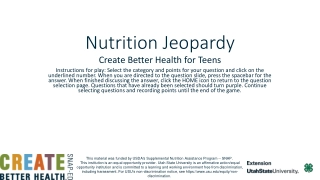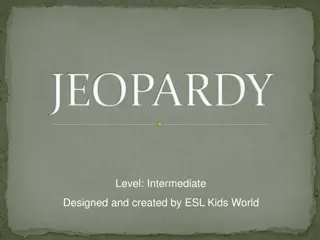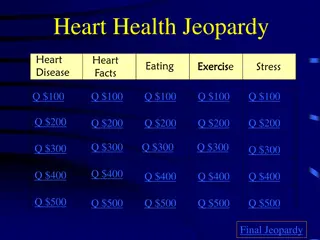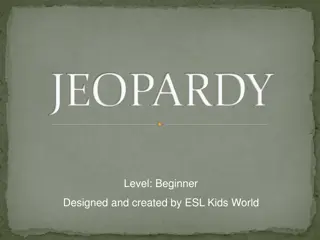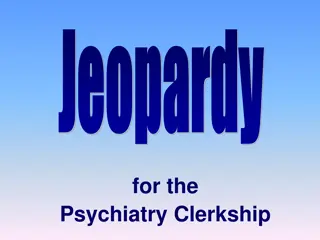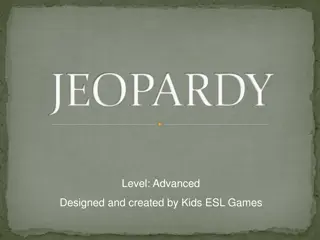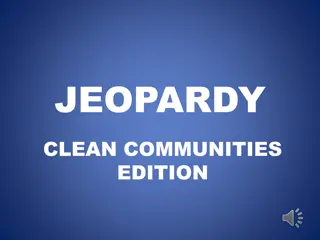Smartboard Jeopardy Lesson Notes
the Smartboard Jeopardy template for interactive learning sessions. Edit questions and answers, keep score, and engage students in a fun and educational game format. Learn how to use the template effectively to enhance teaching experiences.
Download Presentation

Please find below an Image/Link to download the presentation.
The content on the website is provided AS IS for your information and personal use only. It may not be sold, licensed, or shared on other websites without obtaining consent from the author.If you encounter any issues during the download, it is possible that the publisher has removed the file from their server.
You are allowed to download the files provided on this website for personal or commercial use, subject to the condition that they are used lawfully. All files are the property of their respective owners.
The content on the website is provided AS IS for your information and personal use only. It may not be sold, licensed, or shared on other websites without obtaining consent from the author.
E N D
Presentation Transcript
Profile of Youth in India Analysis of NFHS-3 Data NFHS-3, India
Youth in India constitutes one-fifth of total population. The youth population has an important role to play as potential demographic dividend by constituting skilled stock of human capital. The youth population also has an important role in demographic evolution. NFHS-3, India
National Youth Policy-2003 The commitment of the entire nation to the composite and all round development of the young sons and daughters of India and seeks to establish an All-India perspective to fulfill their legitimate aspirations so that they are all strong of heart and strong of body and mind in successfully accomplishing the challenging task of national reconstruction and social changes that lie ahead. NFHS-3, India
Contents of Presentation Profile of youth Knowledge about selected health related issues Attitudes towards selected population, health and gender concerns Behaviour of youth in health related spheres Health and nutritional profile of youth NFHS-3, India
Profile of Youth Education Mass media exposure Employment Marriage NFHS-3, India
UNFPA definition of youth, population - age 15-24 - is adopted for this report NFHS-3 interviewed 47,590 women and 24,997 men age 15-24: Women Men Age-group 15-19 20-24 15-24 13,008 11,989 24,811 22,779 47,590 24,997 31% of women and 38% of men are from urban areas 37% of women and 32% of men are from the two lowest wealth quintiles NFHS-3, India
Literacy Rates Among Youth Age-group Women Men 15-19 74 89 20-24 64 84 15-24 25-49 69 46 86 73 Literacy rate among women Age 15-77% , age 24 - 63% Urban 86%, rural 62% Never married 84%, ever married 55% Poorest HHs 33%, richest HHs 97% NFHS-3, India
Education Among Youth Completed years of education Women (%) 26 Men (%) 10 No education < 5 years complete 7 8 5-7 years complete 18 18 8-9 years complete 20 15 27 19 10-11 years complete 12+ years complete 14 19 Total 100 100 29% of women (47% of urban and 20% of rural) have 10+ years of schooling. 38% of men (49% of urban and 31% of rural) have 10+ years of schooling. NFHS-3, India
School Enrollment Among Youth School attendance rate at age 15-17 34% of women and 49% of men age 15-17 attended school in the year 2004-05. 73 68 Women Men 54 45 44 39 30 28 20 13 Poorest Poorer Middle Richer Richest
Most youth are exposed to some form of media 70% of women and 88% of men have at least weekly exposure to television, radio, or newspapers/magazines. Majority of women with no education and women in rural areas are not regularly exposed to any media. NFHS-3, India
Employment among Youth Women Men Percent 92 89 87 79 78 65 63 49 43 36 36 35 34 34 34 33 33 33 33 31 15 16 17 18 19 20 21 22 23 24 NFHS-3, India
Many youth are economically active. 36% of women and 67% of men age 15-24 are employed. Almost all men with no education and ever married men are employed. The majority of employed women are agricultural workers; whereas, there is greater diversity in male employment. Less than two-thirds of employed women (63%) earn cash for their work, compared with 88 percent of employed men. NFHS-3, India
Percentage of Married Youth by Age Figures in white indicate percentage married excluding gauna not performed Figures in yellow indicate percentage married including gauna not performed 86 80 Men 75 Women 86 70 80 63 75 69 53 51 62 50 42 3640 52 39 27 26 40 34 20 18 26 12 9 23 8 18 3 2 2 14 7 5 8 2 0 0 15 16 17 18 19 20 21 22 23 24 15 16 17 18 19 20 21 22 23 24 NFHS-3, India
Many youth marry below legal age at marriage Half of women and about one in five men age 15-24 are married. 19% of women age 15-17 and 7% of men age 15-20 are married. In Bihar (38%), Jharkhand (36%), Rajasthan (31%), and West Bengal (26%) more than one- fourth of women age 15-17 are arried, though many of them have not started living with husband. NFHS-3, India
Many youth are heading households One percent of women and 8% of men age 15-24 are household heads. 29% of currently married men age 15-24 are heading their own households. Youth in households headed by youth are poorer than youth in households headed by someone who is older. NFHS-3, India
Knowledge of Youth of Selected Family Planning and Health Issues Knowledge of family planning methods Awareness of AIDS Knowledge of HIV/AIDS NFHS-3, India
Most youth have heard of available modern contraceptive spacing methods 93% of women know of female sterilization, but only 83 percent know about pills and 71 percent each know about IUDs and condoms. 93% of men know about condoms, but only 78 percent know about pills and 37 percent know about the IUD. Only 8% of women and 15% of men know about emergency contraception. NFHS-3, India
A majority of youth lack comprehensive knowledge of HIV/AIDS About two-thirds of women and 88 percent of men have heard of AIDS . Three out of four men know that the risk of HIV/AIDS can be reduced by condom use or by limiting sex to one uninfected partner; however, less than half of women know about these ways of HIV/AIDS prevention. Only 20 percent of women and 36 percent of men have comprehensive knowledge about HIV/AIDS. In many states, less than one-half of women have heard of AIDS. NFHS-3, India
In high HIV prevalence states many youth are not aware of AIDS. In two high HIV prevalence states of Manipur and Tamil Nadu, almost all young women and men are aware of AIDS. In the remaining four high prevalence states of Maharashtra, Nagaland, Andhra Pradesh and Karnataka less than 76-86 percent of women but 90-95 percent men know of AIDS. NFHS-3, India
Youths Attitudes toward Selected Population, Health and Gender Concerns Family size preference Family life education Gender role attitudes NFHS-3, India
Family Size Preferences Percent distribution of women and men by ideal number of children Women Men 0 0 1 2 2 1 1 53 5 11 11 2 2 13 15 3 3 4+ 65 67 4+ Non- numeric non- numeric NFHS-3, India
Youths attitude toward gender roles is, in general, no more egalitarian than the attitude of the older cohort age 25-49 More than half of youth (53% of women and 56% of men) agree that it is justified for a husband to beat his wife under specific circumstances. About two-thirds of youth (64% of women and 68% of men) believe that a woman is justified in refusing to have sex with her husband for specific reasons. NFHS-3, India
Behaviour of Youth in Health related Spheres Initiation of fertility Family planning use and unmet need Sexual behaviour Consumption of tobacco and alcohol NFHS-3, India
Initiation of childbearing Percentage of women who have begun childbearing by age 81 73 68 59 49 36 24 13 6 3 15 16 17 18 19 20 21 22 23 24 Age NFHS-3, India
Early childbearing is the main feature of India s fertility pattern According to current fertility schedule, by the time a woman in India reaches age 25, she already has on an average 1.5 children. More than half of total fertility is realized by the time women reaches age 25. In all the states except Goa, by the time women reach age 25, they already have on an average at least one child. NFHS-3, India
Trend in Contraceptive Prevalence Rate Percentage of currently married women 33 28 26 21 20 16 13 8 7 15-19 years 20-24 years 15-24 years NFHS-1 NFHS-2 NFHS-3 NFHS-3, India
Family Planning Method Choice of Youth Among the teenagers, the methods most often used are rhythm (4%), condom (3%), and withdrawal and pill (2% each). One percent of teenagers have already undergone sterilization. Among the age group 20-24, female sterilization is the preferred method. 13% of women age 20-24 are sterilized. Among women age 20-24 also, 7 percent of women have chosen traditional methods, though condom (6%) and pill (4%) are also used by a sizeable proportion. NFHS-3, India
Pattern of contraceptive use by youth reveals son preference Percentage of currently married women with two children using contraception 58 50 50 Both sons 43 One son, one daughter 31 Both daughters 24 Any method Sterilization NFHS-3, India
Youth in India has a large unmet need for family planning. 27% of teenage women and 21% of women age 20-24 have unmet need for family planning. 25% of teenage women and 15% of women age 20-24 have unmet need for spacing. There has been is only a small decrease in the unmet need for family planning since NFHS-2. NFHS-3, India
Early marriage leads to early initiation of sexual activity among women 51% of women and 27% of men age 15-24 have ever had sexual intercourse. One in every 10 women and 2% of men had sexual intercourse before age 15 years. Among never married youth, 12% of men and less than 1% of women report ever having had sexual intercourse. NFHS-3, India
There is evidence of higher-risk sex among male youth unprotected by condom use. Among youth who have ever had sexual inter-course, men on average have had 1.8 partners, and women have had slightly more than one partner. Among the 22% of men who had sexual intercourse in the 12 months prior to the survey, a little more than one-quarter had higher-risk intercourse, i.e., they had intercourse with a partner who was neither a spouse nor lived with them. Among men who had higher-risk sexual intercourse, a little more than one-third used a condom at last higher- risk intercourse. NFHS-3, India
T Tobacco use and alcohol consumption are matters of concern. 40% of men use tobacco in some form, including 19% who smoke cigarettes/bidis and 30 percent who consume paan masala, gutkha, or other tobacco products. 5% of female youth report tobacco use, mainly in the form of chewing tobacco. One-fifth of young men and 1 percent of young women age 15-24 consume alcohol. Tobacco and alcohol consumption begin early: Even among men who are only 15 years of age, 16 percent use some form of tobacco and 6 percent consume alcohol. NFHS-3, India
T Tobacco use and alcohol consumption among men begin early Smoke Use Tobacco Drinks Alcohol Percentage 57 56 54 50 48 39 38 32 32 31 28 28 24 23 18 31 16 15 29 28 25 23 9 8 18 17 6 6 12 9 15 16 17 18 19 20 21 22 23 24 Age NFHS-3, India
Health and Nutritional Profile of Youth Prevalence of sexually transmitted infections Prevalence of HIV Nutritional status Anaemia Domestic violence NFHS-3, India
Prevalence of Sexually Transmitted Infections (STIs) and STI Symptoms Percentage of women and men who ever had sexual intercourse reporting having an STI and/or symptoms of STI in the past 12 months 11 11 11 11 7 15-19 20-24 4 25-49 Women Men NFHS-3, India
Prevalence of STIs and STI symptoms is higher among never married men. 13 12 11 11 9 7 Never married 6 6 6 Ever married 5 15-19 20-24 Urban Rural Total NFHS-3, India
HIV Prevalence Among Youth Women Men % 0.01 0.19 Total Age 15-19 20-24 0.07 0.17 0.04 0.18 Residence Urban Rural 0.16 0.09 0.11 0.11 0.08 0.09 0.14 0.09 0.10 Total NFHS-3, India
HIV Prevalence Among Youth in High HIV States Percentage 0.48 0.39 0.38 0.35 0.33 0.31 0.29 Women Men 0.18 0.14 0 Maharashtra Tamil Nadu Andhra Pradesh Karnataka Manipur NFHS-3, India
Nutritional Status of Youth 2 2 5 6 13 18 40 51 53 60 60 52 Overweight/obese Normal Total thin 58 47 41 36 31 27 15-19 20-24 25-49 15-19 20-24 25-49 Men Women NFHS-3, India
Anaemia Among Youth 56% 57% 56% Severe Moderate Mild 2 2 2 15 17 15 30% 1 24% 19% 1 12 39 39 38 1 10 7 17 13 11 15-19 20-24 25-49 15-19 20-24 25-49 Men Women NFHS-3, India
The high prevalence of spousal violence is a continuing hurdle to the achievement of health goals and gender equality More than one in three married female youth (37%) have experienced physical, sexual, or emotional violence by their husband. Seven percent of all female youth and 11 percent of married female youth have experienced sexual violence. NFHS-3, India
Concluding Remarks To fully exploit the demographic dividend, India s youth need to be healthy, educated, skilled and forward looking. However, the report points out a few weak areas. A sizeable proportion lacks education, even literacy Early marriage Burdened with childbearing and rearing Large unmet need for family planning Poor nutritional status Substance abuse In knowledge, attitude and behaviour youth is not very different from the older counterpart. NFHS-3, India
Concluding Remarks In knowledge, attitude and behaviour use is not very different from the older counterpart. NFHS-3, India
Thank You NFHS-3, India


